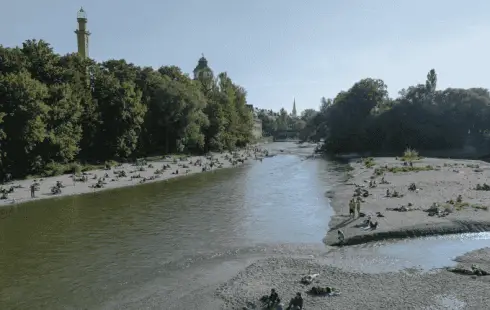
Crypto Investment Entry and Exit Strategies of Institutional Investors
Section: Business
 The Isar River, once a wild and untamed waterway in the 18th century, later tamed into a corseted canal, is now an urban oasis and a favorite swimming spot for the people of Munich. Thanks to the Isar Plan renaturation project, Munich residents and visitors can once again enjoy the river's natural beauty while creating a harmonious space for both humans and wildlife. Join us on a tour of the Isar River's remarkable transformation.
The Isar River, once a wild and untamed waterway in the 18th century, later tamed into a corseted canal, is now an urban oasis and a favorite swimming spot for the people of Munich. Thanks to the Isar Plan renaturation project, Munich residents and visitors can once again enjoy the river's natural beauty while creating a harmonious space for both humans and wildlife. Join us on a tour of the Isar River's remarkable transformation.
As sustainability efforts gain momentum worldwide, it is crucial to highlight projects that have successfully transitioned towards greater environmental friendliness. The Isar renaturation project stands as a prime example of such success, attracting attention from various quarters. Stefan Homilius, head of the Munich Water Management Office, emphasized the importance of environmental consciousness and responsible water management. "Environmental awareness and the positive treatment of our bodies of water is a major concern for us," he stated. "That's why we offer on-demand tours, preferably for institutions that are concerned with the environment, water, and environmental education."
Adventurous sustainability enthusiasts can also explore the renaturalized river independently. A half-day excursion along the "Nature" theme trail beyond the city limits, spanning less than 10 km between the Dürnsteiner Bridge near Schäftlarn and the Ickinger Weir, offers an informative journey with eleven information panels along the route. For those seeking a shorter urban adventure, a four-stop city walk begins at the Wittelsbacher Bridge and concludes at Isarwerk 2 near the Flaucher, spanning a comfortable 2½ km and taking approximately an hour to complete. Below, we present the most important stops along this captivating renaturation tour.
1st Stop: The Wittelsbach Bridge - Defending Against Floods
Our journey commences at the Wittelsbach Bridge, a historical landmark with a crucial role in Munich's flood history. In 1899, during a devastating flood, the previous iron bridge proved its resilience as one of the few bridges that withstood the deluge. However, the city decided to further straighten the Isar in the late 1950s after experiencing more destructive floods in the late 1950s. "Sections of the Isar in the city were heavily channelized until we started implementing the Isar Plan," explained Stefan Homilius. This "corset" approach had detrimental effects, nearly obliterating river-side habitats for both humans and animals.
The Isar Plan was the turning point, with its three-fold objectives of ensuring flood safety for Munich residents, enhancing ecological balance, and providing recreational opportunities. Between 2000 and 2011, extensive restoration work transformed the Isar. North of the Wittelsbach Bridge, a willow island emerged as a retreat for flora and fauna, creating a shared space for animals and people. Today, the steps built around the Wittelsbach Bridge, a part of the renaturation project, are bustling with activity during the summer, drawing Munich residents who seek to embrace nature amidst the urban setting.
2nd Stop: Braunau Railroad Bridge - Natural Havens
Our second stop takes us to the Braunau Railroad Bridge, a sensitive site during floods due to the risk of debris getting wedged against the bridge piers. Renaturation work fortified the embankment with limestone to divert the river's strongest currents away from the bridge's piers, enhancing safety and resilience.
As you continue on, you'll notice strategically placed tree trunks along the way. These are not remnants of past floods but deliberate installations to prevent the formation of trails that can cause erosion and deepen the riverbed during floods.
3rd Stop: The Flaucher - A Hub for Recreation and Ecological Growth
The journey proceeds to the Flaucher, a popular spot for swimming, barbecuing, and relaxation during Munich's summers. The crystal-clear water here is a testament to successful sewage treatment efforts upstream. Stefan Homilius noted, "In the upper section of the Isar, we installed sewage treatment plants equipped with disinfection systems to prevent pathogens from entering the water. This ensures the river has the right bathing quality."
Before renaturation, fish reproduction near the Flaucher seemed inconceivable. Hence, the Isar Plan designated special resting zones for fish. The ecological improvements are not limited to fish; the area now boasts a diverse range of insects and butterflies, including species like the Adonis Blue and the Checkered Skipper Butterfly.
4th Stop: The Isarwerk - Harnessing Green Energy
Our final destination is the Isarwerk, a testament to the integration of nature conservation and environmentally friendly energy generation. This site, established at the beginning of the 20th century, houses hydroelectric power plants along with the Isar-Werkkanal, where electricity is generated from a side arm of the Isar. Striking a balance between maintaining the Isar's water level and eco-friendly energy production is paramount here.
As our tour concludes, Stefan Homilius recommends, "Just put your feet in the Isar and experience it for yourself. In my opinion, that's an even better way of understanding renaturation than having it explained to you."
A quarter of a century since the inception of the renaturation project, the Isar River and its floodplains have become vital facets of Munich's identity. Their success story serves as an inspiring example of large-scale sustainability projects that can triumph over time, offering hope and guidance to companies with ambitious sustainability goals.
Isar Muellersches Volksbad, © Muenchen Tourismus, Luis Gervasi

Section: Business

Section: Arts

Section: Arts

Section: Business

Section: Business

Section: Arts

Section: Health

Section: Arts

Section: News

Section: News
Health Insurance in Germany is compulsory and sometimes complicated, not to mention expensive. As an expat, you are required to navigate this landscape within weeks of arriving, so check our FAQ on PKV. For our guide on resources and access to agents who can give you a competitive quote, try our PKV Cost comparison tool.
Germany is famous for its medical expertise and extensive number of hospitals and clinics. See this comprehensive directory of hospitals and clinics across the country, complete with links to their websites, addresses, contact info, and specializations/services.
One of the most beautiful squares transforms into a summer stage every year for two days. The Gärtnerplatz Open-Air features a free music and cultural program across three stages, as well as street food from local vendors. On Saturday, the main stage at Gärtnerplatz offers something for everyone,...



No comments yet. Be the first to comment!